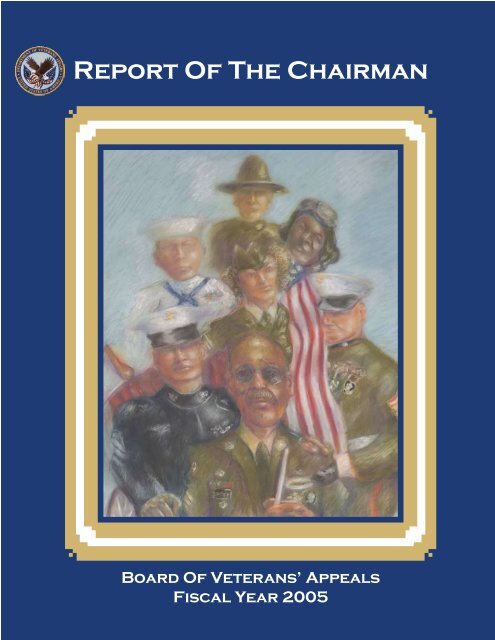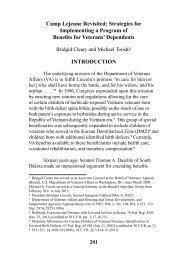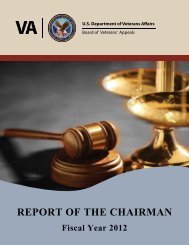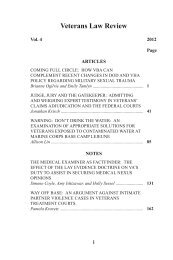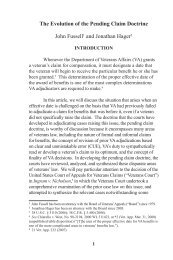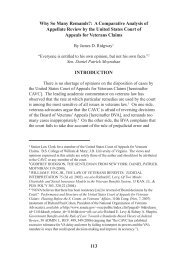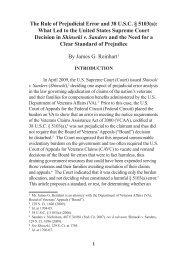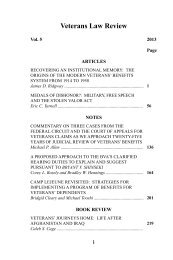Report Of The Chairman - Board of Veterans
Report Of The Chairman - Board of Veterans
Report Of The Chairman - Board of Veterans
Create successful ePaper yourself
Turn your PDF publications into a flip-book with our unique Google optimized e-Paper software.
<strong>Report</strong> <strong>Of</strong> <strong>The</strong> <strong>Chairman</strong><strong>Board</strong> <strong>Of</strong> <strong>Veterans</strong>’ AppealsFiscal Year 2005
DEPARTMENT OF VETERANS AFFAIRS<strong>Chairman</strong>, <strong>Board</strong> <strong>of</strong> <strong>Veterans</strong>’ AppealsWashington DC 20420January 31, 2006<strong>The</strong> Honorable R. James NicholsonSecretary <strong>of</strong> <strong>Veterans</strong> AffairsDepartment <strong>of</strong> <strong>Veterans</strong> Affairs810 Vermont Avenue, N.W.Washington, DC 20420Dear Mr. Secretary:I am pleased to present the Fiscal Year 2005 <strong>Report</strong> <strong>of</strong> the <strong>Chairman</strong>, <strong>Board</strong> <strong>of</strong> <strong>Veterans</strong>’Appeals (<strong>Board</strong> or BVA), for inclusion in your submission to Congress. Information on theactivities <strong>of</strong> the <strong>Board</strong> during Fiscal Year 2005 and the projected activities <strong>of</strong> the <strong>Board</strong> for FiscalYears 2006 and 2007, as required by 38 U.S.C. § 7101(d)(1), are provided in Parts I and II.Fiscal Year 2005 saw the <strong>Board</strong> increase productivity, despite decreased resources. <strong>The</strong><strong>Board</strong> conducted a record number <strong>of</strong> personal hearings and also focused on training andsuccession planning.Although veterans benefits law continued to change, the employees <strong>of</strong> the <strong>Board</strong> neverlost sight <strong>of</strong> the mission to produce timely, quality decisions for the veterans we serve.Nor did they lose sight <strong>of</strong> our obligation to treat veterans and their families with care andcompassion.I believe the enclosed report will provide you, the Congress, and the veterans we serve withan accurate and meaningful perspective on the <strong>Board</strong>’s activities during Fiscal Year 2005.Very respectfully,EnclosureJames P. Terry<strong>Chairman</strong>
REPORT OF THE CHAIRMAN FY 05Table <strong>of</strong> ContentsIntroduction ................................................................................ 1Part I: Activities <strong>Of</strong> <strong>The</strong> <strong>Board</strong> <strong>Of</strong> <strong>Veterans</strong>’ AppealsFiscal Year 2005 ........................................................................2CHALLENGES ..................................................................................... 3THE BOARD’S PRIMARY OBJECTIVES FOR FISCAL YEARS 2006 AND 2007 ..... 31. Eliminate Avoidable Remands .................................................... 32. Eliminate the Backlog ................................................................ 53. Improve Quality ....................................................................... 64. Succession Planning .................................................................. 6FISCAL YEAR 2005 HIGHLIGHTS .......................................................... 6ASSISTANCE TO VBA REGIONAL OFFICES ........................................... 7HEARING TRANSCRIPTS .................................................................... 7VETERANS SERVICE ORGANIZATION (VSO) FORUMS .......................... 7VOLUNTEER ACTIVITIES .................................................................... 7PLANNING FOR THE FUTURE ............................................................. 8<strong>Board</strong> Members ........................................................................... 9Part II: Statistical Data ............................................................ 10Projections For Fiscal Years 2006 And 2007 ................. 13Additional Information ............................................................ 15
REPORT OF THE CHAIRMAN FY 05Introduction<strong>The</strong> law requires that the <strong>Chairman</strong> <strong>of</strong> the <strong>Board</strong> <strong>of</strong> <strong>Veterans</strong>’ Appeals (<strong>Board</strong> or BVA) report theactivities <strong>of</strong> the <strong>Board</strong> at the conclusion <strong>of</strong> each fiscal year. This report includes two parts. Part Iprovides a discussion <strong>of</strong> BVA activities during Fiscal Year 2005 and projected activities for FiscalYears 2006 and 2007. Part II provides statistical information related to our activities during FiscalYear 2005 and projected activities for Fiscal Years 2006 and 2007.<strong>The</strong> <strong>Board</strong> makes final decisions on behalf <strong>of</strong> the Secretary on appeals from decisions <strong>of</strong> localDepartment <strong>of</strong> <strong>Veterans</strong> Affairs (VA) <strong>of</strong>fices. <strong>The</strong> <strong>Board</strong> reviews all appeals for entitlement toveterans’ benefits, including claims for service connection, increased disability ratings, totaldisability ratings, pension, insurance benefits, educational benefits, home loan guaranties,vocational rehabilitation, dependency and indemnity compensation, and health care delivery.<strong>The</strong> <strong>Board</strong>’s mission, as set forth in 38 U.S.C. § 7101(a), is “to conduct hearings and dispose <strong>of</strong>appeals properly before the <strong>Board</strong> in a timely manner.” <strong>The</strong> <strong>Board</strong>’s goal is to issue qualitydecisions in compliance with the requirements <strong>of</strong> the law, including the precedential decisions <strong>of</strong>the United States Court <strong>of</strong> Appeals for <strong>Veterans</strong> Claims (CAVC) and other federal courts.<strong>Board</strong> Members/<strong>Veterans</strong> Law Judges1
REPORT OF THE CHAIRMAN FY 05Part IActivities <strong>Of</strong> <strong>The</strong> <strong>Board</strong> <strong>Of</strong> <strong>Veterans</strong>’ AppealsFiscal Year 2005In Fiscal Year 2005, the <strong>Board</strong> focused on conducting hearings and issuing decisions in a timelymanner for our Nation’s veterans and their families. With a business-plan strength <strong>of</strong> 56 <strong>Veterans</strong>Law Judges (VLJs), the <strong>Board</strong> conducted 8,576 hearings and issued 34,175 decisions with acycle time <strong>of</strong> 104 days. Cycle time measures the time from the date an appeal is physicallyreceived at the <strong>Board</strong> until a decision is dispatched, excluding the time the case is with a serviceorganization representative.In Fiscal Year 2005, the <strong>Board</strong> continued to implement its succession plan. Five new VLJs wereappointed to the <strong>Board</strong> through a competitive selection process to replace departing VLJs. Four<strong>of</strong> the new VLJs came from the <strong>Board</strong>’s staff <strong>of</strong> eight Senior Counsel, which in turn resulted inthe competitive selection <strong>of</strong> four new Senior Counsel.On July 14, 2005, the United States Senate Committee on <strong>Veterans</strong> Affairs held a confirmationhearing for James P. Terry, who was nominated by the President <strong>of</strong> the United States toa six-year term appointment as <strong>Chairman</strong> <strong>of</strong> the <strong>Board</strong>. On July 31, 2005, the United StatesSenate confirmed the nomination. <strong>The</strong> <strong>Board</strong> enthusiastically welcomed <strong>Chairman</strong> Terry andimmediately pledged its support for his efforts to improve decision output and quality.<strong>The</strong> Honorable R. James Nicholson swears in James P. Terry as <strong>Chairman</strong>2
REPORT OF THE CHAIRMAN FY 05CHALLENGESDespite efforts to issue more decisions, the <strong>Board</strong> continues to receive more appeals than it isdeciding. Case receipts for Fiscal Year 2005 were 41,816, and the number <strong>of</strong> cases pending beforethe <strong>Board</strong> at the end <strong>of</strong> Fiscal Year 2005 was 37,539. <strong>The</strong> <strong>Board</strong>’s most significant challenge forthe future is eliminating the growing backlog with available resources.As the backlog grew during Fiscal Year 2005, the <strong>Board</strong> aggressively focused on methods to increasedecision output. <strong>The</strong>se methods included efforts to eliminate avoidable remands, voluntaryattorney overtime, production incentives for attorneys, and training VLJs and attorneys to writeclear, concise, coherent, and correct decisions. However, case receipts continued to eclipse output.<strong>The</strong> number <strong>of</strong> appeals received in Fiscal Year 2005 (41,816) was greater than those received inFiscal Year 2004 (39,956). In Fiscal Year 2006, the <strong>Board</strong> projects that case receipts will increasefurther, to approximately 43,000 appeals.In addition to the increase in case receipts, the 8,576 hearings conducted by the <strong>Board</strong> in FiscalYear 2005 is a dramatic increase from the 7,259 conducted in Fiscal Year 2004, and the 6,046conducted in Fiscal Year 2003. <strong>The</strong> <strong>Board</strong> completed this record-setting number <strong>of</strong> hearingswithout an increase in the number <strong>of</strong> VLJs. If the number <strong>of</strong> hearings conducted continues toincrease by approximately 20% each fiscal year, the <strong>Board</strong> will face a significant challenge toissue decisions and conduct hearings in a timely manner.THE BOARD’S PRIMARY OBJECTIVES FOR FISCAL YEARS 2006 AND 20071. Eliminate Avoidable Remands<strong>Veterans</strong> want timely and correct decisions on claims for benefits. <strong>The</strong> record must contain allevidence necessary to decide the claim and show that all necessary due process has been provided.If the record does not meet these requirements, and the benefits sought cannot be granted, aremand for further development is necessary. However, remands from the <strong>Board</strong> to the Agency<strong>of</strong> Original Jurisdiction (AOJ) significantly increase the time it takes for a veteran to receive afinal decision. A remand adds about a year to the appellate process. Furthermore, about 75% <strong>of</strong>cases remanded by the <strong>Board</strong> are subsequently returned to the <strong>Board</strong>, which increases the <strong>Board</strong>’sworkload and degrades timeliness. Eliminating avoidable remands is a goal that will providebetter service to veterans and their families and, ultimately, help diminish the growing backlog.<strong>The</strong> <strong>Board</strong> and the <strong>Veterans</strong> Benefits Administration (VBA) began developing an action plan toreduce the number <strong>of</strong> avoidable <strong>Board</strong> remands beginning in late Fiscal Year 2004. <strong>The</strong> followinginitiatives were part <strong>of</strong> the action plan:--Data Collection: First, the <strong>Board</strong> and VBA agreed upon a reliable process forcapturing information prospectively on reasons for remand, and conducted aretrospective analysis <strong>of</strong> a sufficiently representative sample <strong>of</strong> <strong>Board</strong> remands tocatalog the various reasons for remand.--Training: Another initiative encompassed training both regional <strong>of</strong>fice (RO) personneland the <strong>Board</strong>’s judges and staff attorneys on topics such as obtaining Social SecurityAdministration records, the <strong>Veterans</strong> Claims Assistance Act <strong>of</strong> 2000 (VCAA) noticerequirements, and medical examinations and opinions. BVA and VBA held joint trainingsessions, including a nationally broadcast video, on avoidable remands and evidence3
REPORT OF THE CHAIRMAN FY 05development. <strong>The</strong> <strong>Board</strong> also held training sessions for its VLJs and staff counsel on avariety <strong>of</strong> medical and legal subjects, aspects <strong>of</strong> remand avoidance, and on how to draftclear and concise remand orders. <strong>The</strong> <strong>Board</strong> will continue to work with VBA and the<strong>Veterans</strong> Health Administration (VHA) on the Compensation and Pension ExaminationProject (CPEP), to improve the quality <strong>of</strong> VA compensation examinations so that remandsto obtain examinations can be reduced.--Concise Explanations in Remands: <strong>The</strong> <strong>Board</strong> will provide a concise explanation<strong>of</strong> the reasons for remand in individual decisions in order to reduce ambiguity andto improve field processing. Better understanding <strong>of</strong> and compliance with remanddirectives will decrease the risk <strong>of</strong> a second remand in a particular case and may helpavoid future remands because <strong>of</strong> the same deficiency.In addition to the joint initiative with VBA, the <strong>Board</strong> explored other courses <strong>of</strong> action to eliminateavoidable remands.--Prejudicial Error Analysis: One reason for the high remand rate in Fiscal Year 2004was the VCAA, which among other things, heightened VA’s duty to assist and duty tonotify claimants <strong>of</strong> the type <strong>of</strong> evidence needed to substantiate their claims.On June 24, 2004, the CAVC issued Pelegrini v. Principi, 18 Vet. App. 112 (2004). Thatdecision held that a VCAA notice letter must be provided to a claimant prior to aninitial adverse adjudication. <strong>The</strong> decision further held that under the governinglaws and regulations VA is required to notify a claimant (1) <strong>of</strong> the information andevidence not <strong>of</strong> record that is necessary to substantiate the claim, (2) which portion<strong>of</strong> that information and evidence VA will seek to obtain, (3) which portion <strong>of</strong> it theclaimant must provide, and (4) that the claimant should submit any evidence in his orher possession that pertains to the claim.Following Pelegrini, the <strong>Board</strong> attempted to avoid remands, when possible, by conductingan analysis to determine if any notice deficiency provided to the claimant was prejudicial.If prejudice was not found, most <strong>Board</strong> judges issued final decisions. If the deficiency wasprejudicial, judges were required to remand the case to the RO to cure the defect.--Waiver <strong>of</strong> AOJ Review: <strong>The</strong> 38.6% remand rate in Fiscal Year 2005 is expected totrend downward due, in part, to implementation <strong>of</strong> a regulatory amendment thatallows the <strong>Board</strong> to request a waiver <strong>of</strong> AOJ review <strong>of</strong> new evidence. Before February22, 2002, if the <strong>Board</strong> accepted any evidence not previously considered by the AOJ, the<strong>Board</strong> was required to refer such evidence to the AOJ for review and preparation <strong>of</strong> aSupplemental Statement <strong>of</strong> the Case, unless the appellant or representative waived, inwriting, initial AOJ consideration <strong>of</strong> the evidence, or the <strong>Board</strong> could fully grant thebenefit(s) sought on appeal. 38 C.F.R. § 20.1304(c)(2001).Effective February 22, 2002, amendments were made to the <strong>Board</strong>’s Appeals Regulationsand Rules <strong>of</strong> Practice. <strong>The</strong>se amendments allowed the <strong>Board</strong> to consider additionalevidence without referring the evidence to the AOJ for initial consideration and withoutobtaining the appellant’s waiver. However, in Disabled American <strong>Veterans</strong> v. Secretary<strong>of</strong> <strong>Veterans</strong> Affairs, 327 F.3d 1339 (Fed. Cir. 2003), the United States Court <strong>of</strong> Appealsfor the Federal Circuit invalidated that portion <strong>of</strong> the <strong>Board</strong>’s regulations that allowedthe <strong>Board</strong> to consider additional evidence without remanding the case to the AOJ forinitial consideration and without obtaining the appellant’s waiver.4
REPORT OF THE CHAIRMAN FY 05Following this decision, the <strong>Board</strong> amended its regulations to add a substantiallysimilar version <strong>of</strong> the prior 38 C.F.R. § 20.1304(c). See 69 Fed. Reg. 53,807 (Sep. 3, 2004).By soliciting waivers in those cases where an appellant or representative submitsevidence without a waiver, the <strong>Board</strong> may avoid unnecessary remands.As a result <strong>of</strong> the above efforts, the <strong>Board</strong>’s remand rate decreased from 56.8% in Fiscal Year 2004to 38.6% for Fiscal Year 2005. We expect further improvement once the <strong>Board</strong> begins reachingcases on its docket that have been subject to VBA’s efforts to reduce avoidable remands.2. Eliminate the Backlog<strong>The</strong> <strong>Board</strong> will focus on eliminating the backlog, within existing resources, by concentrating onthe following:--Eliminating avoidable remands: <strong>The</strong> ongoing reduction in remands in Fiscal Year2005 and expected reduction in Fiscal Year 2006 will help reduce backlog growth.Fewer remands mean fewer appeals pending before the <strong>Board</strong> and, thus, a reducedbacklog. At the end <strong>of</strong> Fiscal Year 2004, there were 31,645 <strong>Board</strong> remands pending atVBA. By the end <strong>of</strong> Fiscal Year 2005, that number had decreased to 25,656. Additionalefforts to eliminate avoidable remands should reduce the number <strong>of</strong> <strong>Board</strong> remandsin the field even further.--Strengthening BVA’s intra-agency partnerships: Joint training efforts with VBA,the <strong>Of</strong>fice <strong>of</strong> the General Counsel (OGC), and VHA will improve case development,decision quality and reduce remands. In addition, the <strong>Board</strong> meets with representativesfrom VHA, VBA and OGC on a monthly basis to discuss areas <strong>of</strong> mutual concern.--Writing clear, concise, coherent, and correct decisions: <strong>The</strong> <strong>Board</strong> is trainingVLJs and attorneys to write clear, concise, coherent, and correct decisions. In the longterm, it is expected that this initiative will enable VLJs and attorneys to produce moreand better <strong>Board</strong> decisions.--Utilizing employee incentive, mentoring and training programs: A number <strong>of</strong>new programs have been introduced to increase employee motivation and satisfaction,as well as to increase productivity and decision quality.--Making use <strong>of</strong> overtime: <strong>The</strong> <strong>Board</strong> will use overtime within existing resources toenhance output.--Increasing our use <strong>of</strong> paralegals: <strong>The</strong> <strong>Board</strong> will use paralegals for non-decisionalsupport activities to free up the legal staff to decide appeals. For example, in FiscalYear 2006, the <strong>Board</strong> will transfer the responsibility <strong>of</strong> drafting a certified list <strong>of</strong> therelevant evidence considered by the <strong>Board</strong> in cases appealed to the CAVC from thestaff counsel to paralegals. In Fiscal Year 2005, the <strong>Board</strong> provided 2,744 certified liststo VA’s OGC. By transferring this responsibility to paralegals, the number <strong>of</strong> draft decisionsproduced by counsel will increase in Fiscal Year 2006.5
REPORT OF THE CHAIRMAN FY 05--Providing improved on-line legal research tools and analytical frameworks:To aid timely and correct decision production.--VLJs will draft decisions: In addition to reviewing decisions drafted by staffcounsel, as time permits.<strong>The</strong>se measures will work to reduce the backlog and to shorten the time it takes for a veteran toreceive a fair, well-reasoned <strong>Board</strong> decision.3. Improve Quality<strong>The</strong> <strong>Board</strong>’s 89% accuracy rate in Fiscal Year 2005 trailed the 93% goal. <strong>The</strong> accuracy rate takesinto account those substantive deficiencies that would be expected to result in a reversal or aremand by the CAVC. Deficiencies in quality that are identified during the <strong>Board</strong>’s qualityreview process are addressed through follow-up training for the VLJs and attorneys.<strong>The</strong> 89% accuracy rate for Fiscal Year 2005 reflects the complexity involved in drafting more finaldecisions, which address the merits <strong>of</strong> a claim, as opposed to remands for further development.In Fiscal Year 2005, 61.4% <strong>of</strong> the <strong>Board</strong>’s decisions were final decisions as compared to 43.2% inFiscal Year 2004. <strong>The</strong> <strong>Board</strong> expects the accuracy rate to improve in Fiscal Year 2006 by way <strong>of</strong>continued training.4. Succession PlanningIn Fiscal Year 2005, five new <strong>Veterans</strong> Law Judges were appointed to the <strong>Board</strong>, and four newSenior Counsel were selected through a competitive selection process. <strong>The</strong> new VLJs and SeniorCounsel were selected from within the <strong>Board</strong>, and four <strong>of</strong> the new VLJs were promoted fromthe Senior Counsel ranks.<strong>The</strong> <strong>Board</strong>’s business plan contemplates that Senior Counsel positions function as training groundsfor future VLJs. Moreover, the creation, in Fiscal Year 2003, <strong>of</strong> two Senior Counsel positions onevery team provides the necessary flexibility to maintain productivity despite short-term personnelshortages. Senior Counsel perform as Acting <strong>Veterans</strong> Law Judges, Team Leaders, and attorneysdrafting decisions. In addition, Senior Counsel mentor and evaluate newly hired attorneys andsupervise more experienced attorneys in need <strong>of</strong> special attention or assistance. <strong>The</strong> creation <strong>of</strong>the Senior Counsel positions has allowed the <strong>Board</strong>’s current leaders to train and mentor futureleaders, and provided significant advancement opportunities for <strong>Board</strong> staff attorneys.<strong>The</strong> <strong>Board</strong> also has a rigorous recruitment program and recruits some <strong>of</strong> the best and thebrightest attorneys and administrative personnel available. <strong>The</strong> <strong>Board</strong> attracts high caliberpersonnel because it is an employer <strong>of</strong> choice, and the mission to serve veterans is one that isparticularly attractive to those seeking a career in public service.FISCAL YEAR 2005 HIGHLIGHTSOn May 5, 2005, the Acting <strong>Chairman</strong>, Ron Garvin, testified before the Subcommittee on DisabilityAssistance and Memorial Affairs, House Committee on <strong>Veterans</strong> Affairs, in an oversight hearingto review the operations at the <strong>Board</strong> and VBA’s Appeals Management Center.6
REPORT OF THE CHAIRMAN FY 05<strong>The</strong> Acting <strong>Chairman</strong> also testified at a hearing <strong>of</strong> the Senate Committee on <strong>Veterans</strong>’ Affairson May 26, 2005. <strong>The</strong> issues centered on the current state <strong>of</strong> the VA claims adjudication andappeals process, specifically focusing on measures that VA is taking to provide timely andaccurate decisions, challenges that VA faces in striving to meet that objective, and measures thatcould be undertaken to address those challenges.ASSISTANCE TO VBA REGIONAL OFFICES<strong>The</strong> <strong>Board</strong> continued to help the ROs reduce their backlog <strong>of</strong> cases on appeal through the Travel<strong>Board</strong> program. For most Travel <strong>Board</strong>s, an attorney travels with a <strong>Veterans</strong> Law Judge to anRO to assist in preparing for scheduled hearings. An average <strong>of</strong> more than 40 hearings arescheduled each week. By mid-week, the cases have been briefed, and the attorneys assist theRO for the remainder <strong>of</strong> the visit.In Fiscal Year 2005, 119 attorneys provided assistance to 57 ROs. <strong>The</strong> attorneys assisted inthe preparation <strong>of</strong> 73 Statements <strong>of</strong> the Case/Supplemental Statements <strong>of</strong> the Case, drafted 15memoranda recommending grants, and conducted training for adjudication personnel at 48 <strong>of</strong>the ROs visited. Additionally, the attorneys, on request, provided non-binding legal advice toadjudicators in 487 cases that were informally reviewed.HEARING TRANSCRIPTSDuring Fiscal Year 2005, the <strong>Board</strong> entered into contracts with four private transcriptiongroups to provide transcripts <strong>of</strong> <strong>Board</strong> hearings. Together, the <strong>Board</strong>’s transcription unitand the contractors produced 8,290 transcripts, and the <strong>Board</strong> ended the fiscal year withfewer transcripts pending than its goal. <strong>The</strong> goal is a working inventory <strong>of</strong> 500 cases, whichrepresents a one-month turnaround for transcription. In order to meet this goal in the future,the <strong>Board</strong> is exploring the use <strong>of</strong> alternative technologies, including voice recognition s<strong>of</strong>tware,stenographers, and real-time transcription.VETERANS SERVICE ORGANIZATION (VSO) FORUMS<strong>The</strong> <strong>Chairman</strong> invites the VSOs and attorneys who represent appellants before the <strong>Board</strong> to VSOForums on a quarterly basis. <strong>The</strong>se meetings address questions that are raised by representativesand also facilitate the exchange <strong>of</strong> ideas and information. <strong>The</strong> <strong>Board</strong> also updates the representativeson the <strong>Board</strong>’s activities and addresses any other matters <strong>of</strong> interest in the open forum.VOLUNTEER ACTIVITIES<strong>The</strong> <strong>Board</strong> serves veterans and their families in many ways. <strong>The</strong> <strong>Board</strong>’s volunteer activitiesinclude:--Educational Exhibits: A <strong>Board</strong> attorney creates and maintains <strong>Veterans</strong> EducationalExhibit cases on five floors <strong>of</strong> the Lafayette Building.--Collection <strong>of</strong> Comfort Items: <strong>The</strong> <strong>Board</strong> collects items, such as toiletries and phonecards, throughout the year and delivers them quarterly to the VA Medical Center andthe U.S. Armed Forces Retirement Home.7
REPORT OF THE CHAIRMAN FY 05-- Items for Homeless <strong>Veterans</strong>: Additional comfort items such as socks, scarves andgloves are collected in conjunction with <strong>Veterans</strong> Day and delivered to the local VAMedical Center for distribution to homeless veterans.--Posters: An attorney with the <strong>Board</strong> distributes U.S. Department <strong>of</strong> Defense and VAPOW/MIA Day and <strong>Veterans</strong> Day posters to veterans, particularly to former POWs.--Toys for Tots: During the holiday season, the <strong>Board</strong> collects Toys for Tots for the U.S.Marine Corps Reserve.--Calendars: <strong>The</strong> <strong>Board</strong> collects and delivers almost 2,000 calendars on an annual basisto veterans at the U.S. Armed Forces Retirement Home in Washington, D.C.--Valentines for <strong>Veterans</strong>: In 2005, the <strong>Board</strong> collected almost 7,000 valentines frommany organizations and individuals around the country and distributed them to theresidents <strong>of</strong> the U.S. Armed Forces Retirement Home in Washington, D.C.--Hurricane Katrina: In September 2005, the <strong>Board</strong> initiated a special collection <strong>of</strong>comfort items for the veterans relocated to the U.S. Armed Forces Retirement Homein Washington, D.C., as a result <strong>of</strong> Hurricane Katrina.PLANNING FOR THE FUTURE--Women’s Leadership Initiative: <strong>The</strong> Women’s Leadership Initiative providesopportunities for all <strong>Board</strong> employees, as well as employees <strong>of</strong> other VA organizations,to improve their leadership skills through training, mentoring, and networking.Events during Fiscal Year 2005 included presentations by Senior Executive Servicemembers, workshops on interviewing and networking, and a luncheon where severaldistinguished guests addressed the art <strong>of</strong> leadership.--Facility Move: In Fiscal Year 2005, the <strong>Board</strong> met regularly with representatives fromthe General Services Administration, VA’s <strong>Of</strong>fice <strong>of</strong> Administration, and others to preparefor a facility move that was scheduled to take place in Fiscal Year 2007. <strong>The</strong> <strong>Board</strong>worked hard to ensure that the needs <strong>of</strong> the <strong>Board</strong>, our <strong>Veterans</strong> Service Organizationpartners, veterans and other appellants who visit the <strong>Board</strong>’s facilities would be met.<strong>The</strong> <strong>Board</strong>’s current location, the Lafayette Building at 811 Vermont Avenue, NW, wasscheduled for a complete renovation starting in Fiscal Year 2007. Although recentinformation reveals that the building renovation and facility move will not take placeas planned, the <strong>Board</strong> continues to work closely with VA’s <strong>Of</strong>fice <strong>of</strong> Administration toconsider available options.8
REPORT OF THE CHAIRMAN FY 05<strong>Board</strong> MembersJames P. Terry, <strong>Chairman</strong>Ron H. Garvin, Vice <strong>Chairman</strong>Steven L. Keller, Senior Deputy Vice <strong>Chairman</strong>Charles E. Hogeboom, Deputy Vice <strong>Chairman</strong>, Decision Team 1Steven L. Cohn, Chief MemberRobert E. Sullivan, Chief MemberJoaquin Aguayo-Pereles, Deputy Vice <strong>Chairman</strong>, Decision Team 2Mark W. Greenstreet, Chief MemberConstance B. Tobias, Chief MemberNancy R. Robin, Deputy Vice <strong>Chairman</strong>, Decision Team 3David C. Spickler, Chief MemberLawrence M. Sullivan, Chief MemberMary M. Sabulsky, Deputy Vice <strong>Chairman</strong>, Decision Team 4Wayne M. Braeuer, Chief MemberHolly E. Moehlmann, Chief MemberVETERANS LAW JUDGESKeith W. Allen Kathleen K. Gallagher Andrew J. MullenMarjorie A. Auer Mary Gallagher John E. OrmondKathy A. Banfield Gary L. Gick Alan S. PeevyBarry F. Bohan Mark F. Halsey Renee M. PelletierDerek R. Brown Mark D. Hindin Ursula R. PowellAnna M. Bryant Vicky L. Jordan Warren W. RiceVito A. Clementi Michelle L. Kane Harvey P. RobertsBarbara B. Copeland Susan L. Kennedy Howard N. SchwartzJohn J. Crowley Michael E. Kilcoyne George R. SenykThomas J. Dannaher Michael D. Lyon Gordon H. ShufeltJonathan E. Day James L. March Deborah W. SingletonPaula M. DiLorenzo Jeffrey J. Martin Charles W. SymanskiShane A. Durkin Cheryl L. Mason Stephen L. WilkinsFrank J. Flowers Joy A. McDonald Richard F. WilliamsJacqueline E. Monroe9
REPORT OF THE CHAIRMAN FY 05Part IIStatistical DataFiscal Year (Fy) 2005 Information<strong>The</strong> following information is required by 38 U.S.C. § 7101(d)(2):38 U.S.C. § 7101(d)(2)(A)Number <strong>of</strong> cases physically received at the <strong>Board</strong> during FY 2005: 41,816Number <strong>of</strong> cases added to docket by filing appeal during FY 2005: 47,13638 U.S.C. § 7101(d)(2)(B)Cases pending before the <strong>Board</strong> at the start <strong>of</strong> FY 2005: 28,815*Cases pending before the <strong>Board</strong> at the end <strong>of</strong> FY 2005: 37,539**Includes certified appeals pending in the field awaiting hearings, as well as cases pending atBVA.38 U.S.C. § 7101(d)(2)(C)Number <strong>of</strong> cases received at BVA and new appeals filed during each <strong>of</strong> the 36 monthspreceding Fiscal Year 2005.Cases Received at BVANew Appeals (VA Form 9) FiledMonth FY02 FY03 FY04 FY05 FY02 FY03 FY04 FY05October 1,392 4,024 1,572 2,664 1,236 3,040 3,855 3,566November 688 2,726 1,152 2,171 1,275 2,720 2,932 3,708December 1,620 3,037 1,583 3,264 1,821 2,634 3,341 3,695January 1,620 4,294 2,616 3,202 2,026 3,185 3,632 3,543February 1,867 4,008 3,519 3,562 2,132 2,906 4,380 3,786March 3,040 4,325 3,996 4,124 2,181 3,605 5,291 4,552April 1,930 3,676 2,975 3,055 2,474 3,717 4,920 3,461May 3,544 2,175 4,856 3,104 2,348 3,675 4,397 4,331June 2,643 3,728 4,359 4,730 2,514 3,797 4,881 4,334July 3,620 2,956 5,371 4,655 1,102 3,719 4,264 3,445August 3,441 2,103 4,637 3,890 993 3,661 3,909 4,378September 2,753 2,917 3,320 3,395 945 4,505 3,836 4,337FY Total 28,158 39,969 39,956 41,816 21,047 41,164 49,638 47,13610
REPORT OF THE CHAIRMAN FY 0550000Cases Received At Bva FY 02 - FY 0545000400003500039,969 39,95641,81643,000300002500028,15820000150001000050000FY02 FY03 FY04 FY05FY06 EstimateNew Appeals (VA Form 9) Filed FY 02 - FY 05500004500049,63847,13647,500400003500041,1643000025000200001500021,0471000050000FY02 FY03 FY04 FY05 FY06 Estimate11
REPORT OF THE CHAIRMAN FY 0538 U.S.C. § 7101(d)(2)(D)<strong>The</strong> average length <strong>of</strong> time a case was before the <strong>Board</strong> between the time <strong>of</strong> the filing <strong>of</strong> anappeal and the disposition during the preceding fiscal year:Time IntervalNotice <strong>of</strong> DisagreementReceipt to Statement <strong>of</strong> the CaseStatement <strong>of</strong> the Case Issuance toSubstantive Appeal ReceiptSubstantive Appeal Receipt toCertification <strong>of</strong> Appeal to BVAReceipt <strong>of</strong> Certified Appeal toIssuance <strong>of</strong> BVA DecisionAverage RemandTime FactorResponsiblePartyField StationAppellantField StationBVAField StationAverage ElapsedProcessing Time187 days47 days590 days160 days190 days38 U.S.C. § 7101(d)(2)(E)<strong>The</strong> number <strong>of</strong> members <strong>of</strong> the <strong>Board</strong> at the end <strong>of</strong> FY 2005: 56 members<strong>The</strong> number <strong>of</strong> pr<strong>of</strong>essional, administrative, clerical, stenographic, and other personnel employedby the <strong>Board</strong> at the end <strong>of</strong> FY 2005: 374 employees not including 56 members above.38 U.S.C. § 7101(d)(2)(F)Number <strong>of</strong> acting members <strong>of</strong> the <strong>Board</strong> during FY 2005: 66Number <strong>of</strong> cases in which such members participated: 3,48638 U.S.C. § 7101(c)(2)Number <strong>of</strong> acting members <strong>of</strong> the <strong>Board</strong> in terms <strong>of</strong> full-time employee equivalents: 5.312
REPORT OF THE CHAIRMAN FY 05Projections For Fiscal Years 2006 And 2007<strong>The</strong> following information is required by 38 U.S.C. § 7101(d)(3):38 U.S.C. § 7101(d)(3)(A)Estimated number <strong>of</strong> cases that will be appealed to BVA:Fiscal Year 2006:Fiscal Year 2007:Cases received at BVA: 43,000Cases added to BVA Docket: 47,500Cases received at BVA: 43,000Cases added to BVA Docket: 48,00038 U.S.C. § 7101(d)(3)(B)Evaluation <strong>of</strong> the ability <strong>of</strong> the <strong>Board</strong> (based on existing and projected personnel levels) toensure timely disposition <strong>of</strong> such appeals as required by 38 U.S.C. § 7101(a):BACKGROUND ON BVA TIMELINESS PROJECTIONS<strong>The</strong> indicator used by the BVA to forecast its future timeliness <strong>of</strong> service delivery is BVA“response time” on appeals. By taking into account the <strong>Board</strong>’s most recent appeals processingrate and the number <strong>of</strong> appeals that are currently pending before the <strong>Board</strong>, BVA responsetime projects the average time that will be required to render decisions on that group <strong>of</strong>pending appeals. For response time computation, the term “appeals pending before the<strong>Board</strong>” includes appeals at the <strong>Board</strong> and those that have been certified for BVA review butare held in the field pending BVA Travel <strong>Board</strong> or video conference hearings.HISTORICAL METHODOLOGYHistorically, BVA computes response time by first determining the <strong>Board</strong>’s average dailyappeals processing rate for the previous year. <strong>The</strong> number <strong>of</strong> appeals pending before the<strong>Board</strong> was then divided by the average daily appeals processing rate. BVA estimated responsetime for Fiscal Year 2006 under this methodology would be computed as follows:Estimated 35,000 decisions in Fiscal Year 2006 divided by 365 days equals 95.89decisions per day.44,456 Estimated Appeals Pending before the BVA (end <strong>of</strong> FY 2006) divided by 95.89Decisions per day equals 464 Days Response Time on Appeals (end <strong>of</strong> FY 2006).Based upon existing and projected levels <strong>of</strong> resources, the estimate <strong>of</strong> BVA responsetime under this methodology would be 464 days for Fiscal Year 2006. This response13
REPORT OF THE CHAIRMAN FY 05time projection is contingent upon BVA’s original appeal receipts estimates for FiscalYear 2006 shown above.NOTE: 464 days divided by 365 calendar days = 1.3 years or 15 months.or by 260 work days = 1.8 years or 21 months.PROPOSED METHODOLOGYIn an effort to create more reliable projections <strong>of</strong> workload and personnel needs, BVA will:Determine “Decisions per Work Day” by dividing FY 2005’s decisions (34,175) by 260work days, i.e., 131.44 Decisions per Work Day.Calculate “Total Workload” by adding the number <strong>of</strong> cases still pending at the end <strong>of</strong>FY 2005 (37,539) to the number <strong>of</strong> new cases anticipated in FY 2006 (43,000), i.e., 80,539Total Workload.Determine “Response Time in Months and Years” by dividing the Total Workload(80,539) by the Decisions per Work Day (131.44), i.e., 613 Work Days; then, dividingthe work days (613) by 260 work days, i.e., 2.4 Years; then, multiplying the years (2.4)by 12 months, i.e., 29 months.Between FY 2003 and FY 2006, BVA’s Total Workload increased by 37.4% (from 58,627 to 80,539)while <strong>Board</strong> Members/Counsel personnel levels grew by only 13.5% (from 258 to 293). Twentyninemonths more accurately reflect the veteran’s wait for BVA’s appeal disposition. Based onexisting personnel levels and an increase in anticipated new cases in the next decade, ResponseTime will continue to lengthen and the <strong>Board</strong>’s backlog <strong>of</strong> cases will continue to grow.14
REPORT OF THE CHAIRMAN FY 05Additional InformationPOTENTIAL BVA WORKLOAD<strong>The</strong> following graph shows the number <strong>of</strong> new notices <strong>of</strong> disagreement received by the regional<strong>of</strong>fices. This information is retrieved directly from the information contained in the <strong>Veterans</strong>Appeals Control and Locator System (VACOLS) at the end <strong>of</strong> the fiscal year. Up to 38.9% <strong>of</strong>the cases over the past four years in which a notice <strong>of</strong> disagreement is filed are resolved at theregional <strong>of</strong>fices and never become appeals.Number <strong>of</strong> New Notices <strong>of</strong> Disagreement Received in the FieldMonth FY02 FY03 FY04 FY05October 4,768 9,936 9,774 8,949November 4,468 8,118 8,621 8,293December 4,534 7,957 6,595 8,016January 5,564 9,670 7,717 9,048February 5,629 9,034 8,718 9,053March 6,707 10,676 11,698 10,265April 7,321 10,419 9,978 9,208May 7,683 9,800 8,574 9,390June 7,197 9,753 9,642 9,256July 8,162 10,084 9,005 8,428August 8,556 9,247 9,797 9,307September 7,551 9,915 8,812 7,468FY Total 78,140 114,609 108,931 106,68115
REPORT OF THE CHAIRMAN FY 05140000notices <strong>of</strong> disagreement received fy 02 - 05120000100000114,609108,931106,681118,000800006000078,14040000200000FY02 FY03 FY04 FY05 FY06 Estimate180000Potential BVA Workload in VBA160000140000120000100000800006000040000200000Oct. 03Nov. 03Dec. 03Jan. 04Feb. 04Mar. 04Apr. 04May 04Jun. 04Jul. 04Aug. 04Sep. 04Oct. 04Nov. 04Dec. 04Jan. 05Feb. 05Mar. 05Apr. 05May 05Jun. 05Jul. 05Aug. 05Sep. 05NODs Form 9s Remands16
REPORT OF THE CHAIRMAN FY 05BVA DECISIONSDuring Fiscal Year 2005, BVA issued 34,175 decisions. Although the total number <strong>of</strong> decisionswas lower than Fiscal Year 2004, the number <strong>of</strong> substantive cases decided in Fiscal Year 2005was significantly higher. One reason for the higher output <strong>of</strong> decisions in Fiscal Year 2004 wasthe “Termination <strong>of</strong> <strong>Board</strong> Development” as reported in the <strong>Report</strong> <strong>of</strong> the <strong>Chairman</strong> FiscalYear 2003. On May 1, 2003, the United States Court <strong>of</strong> Appeals for the Federal Circuit (FederalCircuit) issued Disabled American <strong>Veterans</strong> v. Secretary <strong>of</strong> <strong>Veterans</strong> Affairs, 327 F.3d 1339 (Fed. Cir.2003). In this decision, the Federal Circuit held that the <strong>Board</strong> could not (except in certainstatutorily authorized exceptions) decide appeals on those cases in which it had developedevidence. <strong>The</strong> impact <strong>of</strong> this decision on the <strong>Board</strong> was substantial. <strong>The</strong> <strong>Board</strong> ceased directingdevelopment and resumed issuing remand decisions in those cases where development hadbeen completed. In June 2003, the <strong>Board</strong> began remanding the 9,000 appeals that were in somestage <strong>of</strong> development by the <strong>Board</strong>, but the benefit sought could not be fully granted. Thatremand process was completed during Fiscal Year 2004.<strong>Board</strong> <strong>of</strong> <strong>Veterans</strong>’ AppealsBVA Dispositions by VA ProgramFY 2005Allowed Remanded Denied Other TotalAppeal Program No. Percent No. Percent No. Percent No. Percent No. PercentBurial Benefits 1 2.1% 11 23.4% 33 70.2% 2 4.3% 47 0.1%Compensation 6,859 21.3% 12,475 38.7% 12,102 37.6% 771 2.4% 32,207 94.2%Education 14 6.0% 75 32.3% 140 60.3% 3 1.3% 232 0.7%Insurance 0 0.0% 7 38.9% 10 55.6% 1 5.6% 18 0.1%Loan Guaranty 1 5.9% 6 35.3% 7 41.2% 3 17.6% 17 0.0%Medical 44 15.2% 121 41.9% 109 37.7% 15 5.2% 289 0.8%Pension 68 11.4% 169 28.4% 336 56.4% 23 3.9% 596 1.7%VR & C 2 3.7% 17 31.5% 30 55.6% 5 9.3% 54 0.2%Other Programs 6 18.2% 11 33.3% 16 48.5% 0 0.0% 33 0.1%BVA OriginalJurisdictionMultipleProgram Areas8 7.8% 3 2.9% 58 56.3% 34 33.0% 103 0.3%93 16.1% 284 49.1% 191 33.0% 11 1.9% 579 1.7%Grand Total 7,096 20.8% 13,179 38.6% 13,032 38.1% 868 2.5% 34,175 100.0%17
REPORT OF THE CHAIRMAN FY 05<strong>Board</strong> <strong>of</strong> <strong>Veterans</strong>’ AppealsBVA Dispositions by RepresentationFY 2005Allowed Remanded Denied Other TotalRepresentation No. Percent No. Percent No. Percent No. Percent No. PercentAmerican Legion 1,336 21.8% 2,438 39.8% 2,207 36.1% 138 2.3% 6,119 17.9%AMVETS 68 21.3% 114 35.7% 128 40.1% 9 2.8% 319 0.9%American Red Cross 14 22.6% 22 35.5% 26 41.9% 0 0.0% 62 0.2%Disabled American<strong>Veterans</strong>Military Order <strong>of</strong>the Purple HeartParalyzed <strong>Veterans</strong><strong>of</strong> America<strong>Veterans</strong> <strong>of</strong> ForeignWarsVietnam <strong>Veterans</strong><strong>of</strong> AmericaState ServiceOrganizations2,457 22.0% 4,382 39.2% 4,046 36.2% 283 2.5% 11,168 32.7%102 22.7% 169 37.6% 174 38.8% 4 0.9% 449 1.3%85 24.1% 150 42.6% 99 28.1% 18 5.1% 352 1.0%618 20.6% 1,149 38.2% 1,134 37.7% 103 3.4% 3,004 8.8%134 23.6% 261 45.9% 153 26.9% 21 3.7% 569 1.7%1,038 19.7% 2,016 38.3% 2,093 39.8% 113 2.1% 5,260 15.4%Attorneys 548 21.3% 1,036 40.3% 902 35.1% 84 3.3% 2,570 7.5%Agents 9 18.4% 20 40.8% 19 38.8% 1 2.0% 49 0.1%Other Representation 106 19.6% 212 39.2% 201 37.2% 22 4.1% 541 1.6%No Representation 581 15.6% 1,210 32.6% 1,850 49.8% 72 1.9% 3,713 10.9%Grand Total 7,096 20.8% 13,179 38.6% 13,032 38.1% 868 2.5% 34,175 100.0%BVA DecisionsFiscal Year Decisions Allowed Remanded Denied Other2002 17,231 27.7% 19.3% 49.9% 3.1%2003 31,397 22.1% 42.6% 32.6% 2.7%2004 38,371 17.1% 56.8%* 24.2% 1.9%2005 34,175 20.8% 38.6% 38.1% 2.5%* <strong>The</strong> 56.8% remand rate for FY 2004 includes former <strong>Board</strong> development cases converted to remands.18
REPORT OF THE CHAIRMAN FY 0545000BVA Decisions FY 02 - FY 0540000350003000031,39738,37134,17535,00025000200001500017,2311000050000FY02 FY03 FY04 FY05 FY06 EstimateBVA Operating StatisticsFY02 FY03 FY04 FY05Decisions 17,231 31,397 38,371 34,175Case Receipts*Added to Docket 21,047 41,164 49,638 47,136Received at BVA 28,158 39,969 39,956 41,816Cases Pending** 18,658 27,230 28,815 37,539Hearings - VACO 470 650 805 738Video 1,475 1,689 2,108 2,618Field 2,556 3,707 4,346 5,220Decision per FTE 38.4 69.9 87.8 79.1BVA FTE 448 451 440 433BVA Cycle Time 86 135 98 104Cost per Case $2,702 $1,493 $1,302 $1,453* Case Receipts composed <strong>of</strong>: (1) new cases added to BVA’s docket; and (2) cases receivedat BVA, which consist <strong>of</strong> all cases physically received at the <strong>Board</strong>, including original appealsand cases returned to the <strong>Board</strong>’s docket (i.e., cases returned following remand development,cases remanded by the Court, and cases received for reconsideration or vacate actions).** Pending figures include certified appeals pending in the field awaiting BVA hearings, aswell as cases pending at the <strong>Board</strong>.19
Department <strong>Of</strong> <strong>Veterans</strong> Affairs<strong>Board</strong> <strong>Of</strong> <strong>Veterans</strong>’ AppealsFiscal YEar 2005


